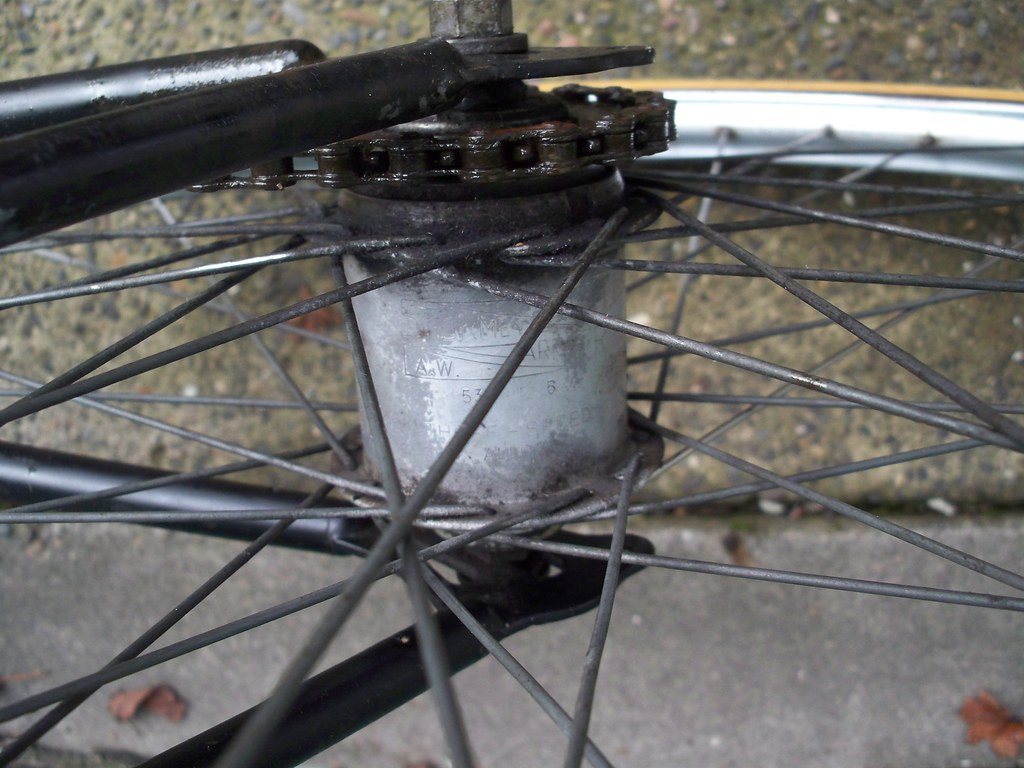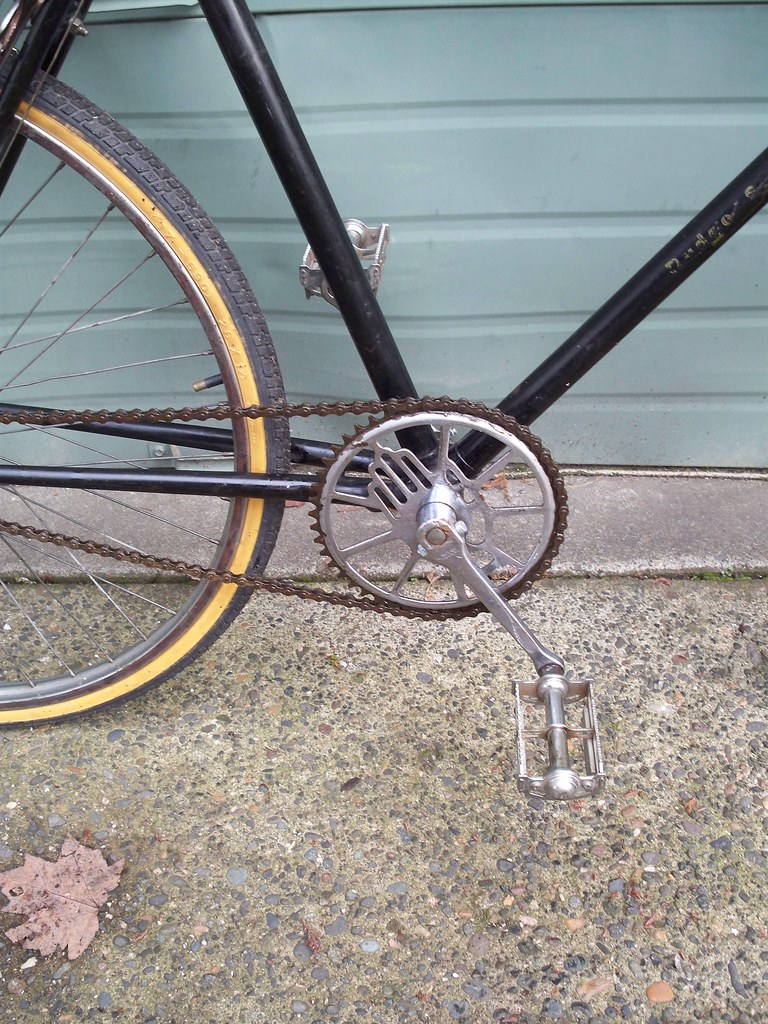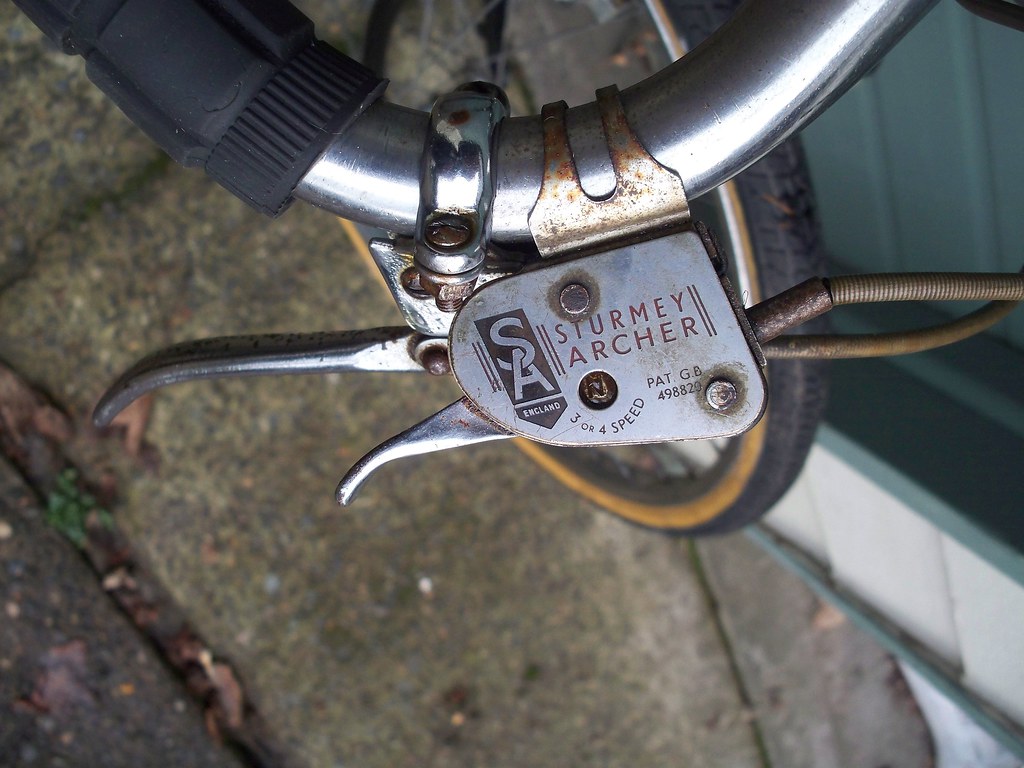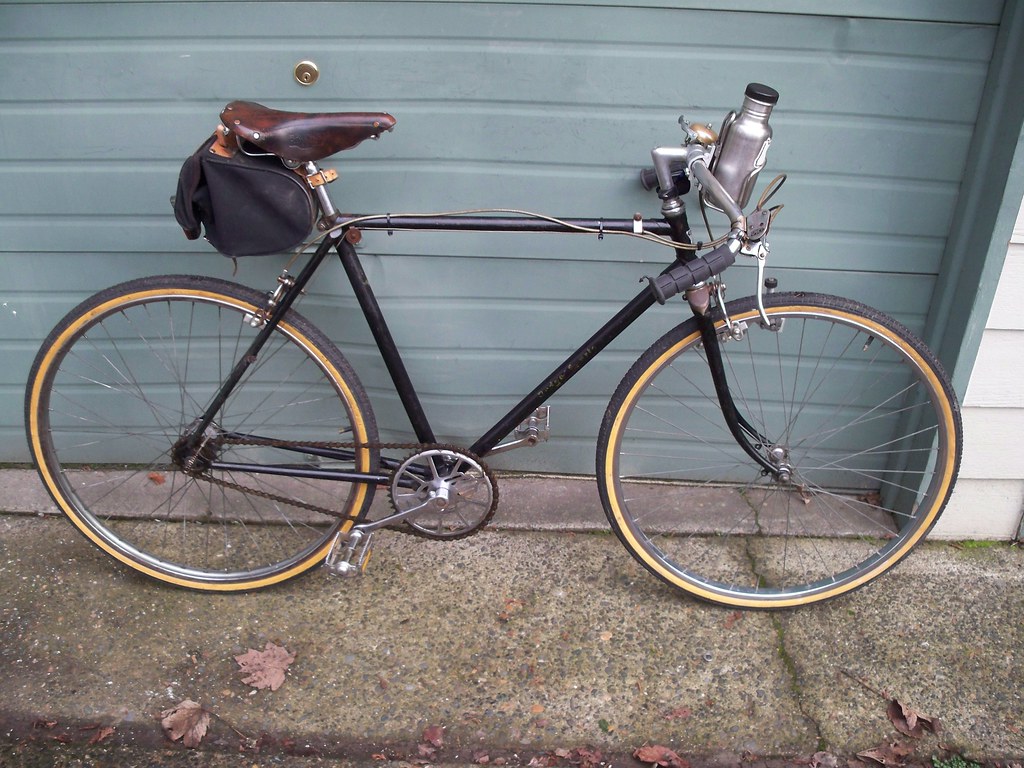The last time we checked in, myself and the Raving Bike Fiend were starting to work on the Rudge. Because the original handlebars sucked, I decided to go the Path Racer route with dropped (or inverted) North Road handlebars and sans fenders. Over the course of a couple days last week (Thurs and Fri), Keith and I put the bike together, to a point I considered "85% done." Then this week on Tuesday we put the finishing touches to make the bike "95% done".
So what did we do?
Wheels/Tires/Mudguards: As stated previously, the front wheel was toast. So we replaced front wheel with another Sturmey-Archer steel rim 650A (26" x 1 3/8"), originally from my Raleigh Wayfarer. For the rear, we replaced the broken spoke, trued it (to some extent). I say to some extent since the rim is still a little bent. But as testament to the strength and quality of these old 40 spoke wheels, it still works! At some point it might be nice to build alloy wheels for the bike, but that's Phase B. When that will happen, I don't know. If I do decide to do it, we'd need to find a different shell for the AW hub because the alloy shell flange is bending. They didn't know how to work with aluminum back in the '50's.
To give it a lower gear range, we took the 18 tooth rear cog off and replaced it with the 20 tooth cog off the Raleigh Wayfarer. (We put a 22 tooth cog on the Wayfarer, along with replacing a spoke.) With a 48 tooth chainring and a Sturmey-Archer AW hub, this gives the following gear-inches: 46.8" for low (1st gear), 62.4" for middle (2nd), and 83.2" for high (3rd). Yes, I am a nerd.
And remember those gumwall Kenda tires and tubes that I found at the Citybikes free pile last month? Yep, they went on the Rudge. Ideally, I'd like something like creme colored Schwalbe Delta Cruisers. But those would cost money! These are free! And actually, the gumwall tire look is growing on me. When they wear out, I will probably upgrade to the Delta Cruisers. But they're fine for now.
And those fenders are gone! Yeah, not good for rain, but this ain't a rain bike. I think removing fenders reduced the weight by about 3 pounds!
Handlebars/Stem/The Cockpit: As stated last time, I found a nice set of used North Road bars that we installed in the dropped or inverted position. The short original stem with another Raleigh branded stem that came off of a roommate's bike. On the bars I put on a spare Crane Brass bell that I had in my stockpile. And for added classiness, I got a VO bottle cage handlebar bracket to affix my bottle cage to the bars.
I'm not sure if I'll keep the current stem so I haven't gone as far as to wrap the bars as I would like. For temporary purposes only, I threw some black OURY grips I had laying around. Yes, Oury grips, the same type I chided the owner of the modernized Phillips 3-speed for "rocking" last month. In my defense, they are temporary, and black does not stand out like pink grips.
Pedals: These came off my Raleigh since I have MKS Lambda pedals on there now. They'll do until I can figure something else out.
Saddle/Seatpost/Saddlebag: I used my Brown Brooks B17 Narrow saddle, last seen on the Centurion Le Mans. The narrow saddle adds to the "sportiness" of the bike, and the brown color contrasts nicely with all the black. My small Minnehaha saddle bag was pulled out of my stockpile. And I found a decent used steel 25.4 seatpost at the Community Cycling Center that replaces the ugly black one.
Lighting: I got a nice 70's vintage Union bottle dynamo/halogen headlamp combo from Justine of Mid-Life Cycling back in the spring. And I figured the Rudge would be a beautiful bike for it! I love the aesthetic. With a little polish it cleaned up well.
Of course, the biggest drawback to an old-school bottle generator lighting (besides the drag and whirring noise) is the lack of a standlight, a light that stays on while the bike's not rolling. Pretty much all modern LED dyno lights have this feature, but before the advent of LED lights in the aughts, a standlight was usually achieved by a complicated battery setup. So I found an old basic Planet Bike LED blinkie light of 2002 vintage. Remember these? They were the first inexpensive LED bike light that was readily available to the masses. It was such a relief after using sucky halogen lights that used C cells and went dim within a day. Yes, somehow I managed to hold on to one of these lights though it's been probably 5 years since I've used one regularly. This will do for a standlight for now.
Drivetrain/Braking/Etc: Threw on a new chain, replaced cables and housing for brakes and 3-Speed cable. Put on salmon-colored Kool Stop brake pads for better stopping power.
On top of all that, there was lots of tweaking, cleaning, oiling, scraping, and polishing. (Oiling a steel frame does wonders for its look, and aluminum foil and lemon juice does a good job of getting rid of surface rust!
And ta-da! The "new" sexy, stripped down Rudge Sports Path Racer!
Next up: Shakedown rides.
So what did we do?
Wheels/Tires/Mudguards: As stated previously, the front wheel was toast. So we replaced front wheel with another Sturmey-Archer steel rim 650A (26" x 1 3/8"), originally from my Raleigh Wayfarer. For the rear, we replaced the broken spoke, trued it (to some extent). I say to some extent since the rim is still a little bent. But as testament to the strength and quality of these old 40 spoke wheels, it still works! At some point it might be nice to build alloy wheels for the bike, but that's Phase B. When that will happen, I don't know. If I do decide to do it, we'd need to find a different shell for the AW hub because the alloy shell flange is bending. They didn't know how to work with aluminum back in the '50's.
To give it a lower gear range, we took the 18 tooth rear cog off and replaced it with the 20 tooth cog off the Raleigh Wayfarer. (We put a 22 tooth cog on the Wayfarer, along with replacing a spoke.) With a 48 tooth chainring and a Sturmey-Archer AW hub, this gives the following gear-inches: 46.8" for low (1st gear), 62.4" for middle (2nd), and 83.2" for high (3rd). Yes, I am a nerd.
And remember those gumwall Kenda tires and tubes that I found at the Citybikes free pile last month? Yep, they went on the Rudge. Ideally, I'd like something like creme colored Schwalbe Delta Cruisers. But those would cost money! These are free! And actually, the gumwall tire look is growing on me. When they wear out, I will probably upgrade to the Delta Cruisers. But they're fine for now.
And those fenders are gone! Yeah, not good for rain, but this ain't a rain bike. I think removing fenders reduced the weight by about 3 pounds!
Handlebars/Stem/The Cockpit: As stated last time, I found a nice set of used North Road bars that we installed in the dropped or inverted position. The short original stem with another Raleigh branded stem that came off of a roommate's bike. On the bars I put on a spare Crane Brass bell that I had in my stockpile. And for added classiness, I got a VO bottle cage handlebar bracket to affix my bottle cage to the bars.
I'm not sure if I'll keep the current stem so I haven't gone as far as to wrap the bars as I would like. For temporary purposes only, I threw some black OURY grips I had laying around. Yes, Oury grips, the same type I chided the owner of the modernized Phillips 3-speed for "rocking" last month. In my defense, they are temporary, and black does not stand out like pink grips.
Pedals: These came off my Raleigh since I have MKS Lambda pedals on there now. They'll do until I can figure something else out.
Saddle/Seatpost/Saddlebag: I used my Brown Brooks B17 Narrow saddle, last seen on the Centurion Le Mans. The narrow saddle adds to the "sportiness" of the bike, and the brown color contrasts nicely with all the black. My small Minnehaha saddle bag was pulled out of my stockpile. And I found a decent used steel 25.4 seatpost at the Community Cycling Center that replaces the ugly black one.
Lighting: I got a nice 70's vintage Union bottle dynamo/halogen headlamp combo from Justine of Mid-Life Cycling back in the spring. And I figured the Rudge would be a beautiful bike for it! I love the aesthetic. With a little polish it cleaned up well.
Of course, the biggest drawback to an old-school bottle generator lighting (besides the drag and whirring noise) is the lack of a standlight, a light that stays on while the bike's not rolling. Pretty much all modern LED dyno lights have this feature, but before the advent of LED lights in the aughts, a standlight was usually achieved by a complicated battery setup. So I found an old basic Planet Bike LED blinkie light of 2002 vintage. Remember these? They were the first inexpensive LED bike light that was readily available to the masses. It was such a relief after using sucky halogen lights that used C cells and went dim within a day. Yes, somehow I managed to hold on to one of these lights though it's been probably 5 years since I've used one regularly. This will do for a standlight for now.
Drivetrain/Braking/Etc: Threw on a new chain, replaced cables and housing for brakes and 3-Speed cable. Put on salmon-colored Kool Stop brake pads for better stopping power.
On top of all that, there was lots of tweaking, cleaning, oiling, scraping, and polishing. (Oiling a steel frame does wonders for its look, and aluminum foil and lemon juice does a good job of getting rid of surface rust!
And ta-da! The "new" sexy, stripped down Rudge Sports Path Racer!
Next up: Shakedown rides.










Cool. I especially like that unique crank.
ReplyDeleteThis is a very cool project. I haven't tried an historically authentic build project yet, but stuff like this post pushes me toward it. Will you sort of swap in more period-appropriate parts (leather brake pads? and the grips of course) as you find them?
ReplyDeleteJohn-Good question. The answer is: probably not. I'm not trying to go for period-correct authenticity. If that was the case, I wouldn't try to achieve the path racer look with a '50's bike.
ReplyDeleteI'm more a practical/functional person when it comes to bikes (though this bike is my least practical bike.) I'll use new parts so long as they fit the look. I'm glad to use as many original parts as I could salvage, though this bike has been modified over the years, so it's hard to say what's truly original. If I had the time/money to build wheels with alloy rims for the Rudge, I'd do it, even though alloy rims were never found on three speeds.
As for leather brake pads, that would be interesting, but I don't know about their stopping power. And I think by the '50's many basic British bikes had moved to rubber brake pads anyway.
Looks great.
ReplyDeleteSweet bike! I followed your comment over from One Speed: Go! I really like the look of this bike: retro-usable. I’d never heard the term “path racer” but dig it. I’ll drop by again. Thanks.
ReplyDeleteNothing cooler than flipped townie bars and a great patina. I'd say the Rudge is shaping up beautifully.
ReplyDeleteAnnie-Yeah, the chainring! I love the Raleigh heron chainring, but there's something about "the hand". And while Raleigh is fairly common States-side, Rudge is not.
ReplyDeleteDan-Thanks!
mindful mule--Path racer refers to racing bikes from about oh 1890 to about WWII. "Path" was just another term for track, and many racing bikes of the early days of bicycles had that style of handlebar. While the Rudge is no racer, it sort of looks like one now.
Stuart-
ReplyDelete"Townie" bars? (eyes bug out)
"Townie" bars?! (starts to hyperventilate)
TOWNIE BARS??!!
Sir, I'll have you know that those are "North Road" bars. I do not own an Electra bicycle! My poor Rudge is offended, and I had to spend several minutes calming her down.
At least you didn't call it a cruiser.
Yours in good fun,
Shawn
I'm envious, I wish I could find something that old and interesting to play with - one day I will - A fine old bike lives again!
ReplyDeleteOh that turned out sa-WEET!!!
ReplyDeleteThe Disabled Cyclist
You could get those newfangled aluminium rims in the 50's but few put much faith in them... my friend has an early 50's Royal Enfield "Sports" with Dunlop Aluminium rims.
ReplyDeleteCan you say "hens teeth ?
Leather brake pads were used for wet weather braking but the leather strips were part of a rubber block.
Proper terminolgy would be path racer or "scorcher" which is what happened to your new bike when you tore off the fenders and chain guard and flipped the north road bars because you could not afford a true club bicycle.
Keith(tRVB)--Yes, I can say hen's teeth.
ReplyDeletehttp://www.guardian.co.uk/education/2006/feb/23/research.highereducation
Re: leather brake pads: were they already sold that way? Could you somehow make a modern version by slapping leather on rubber brake pads?